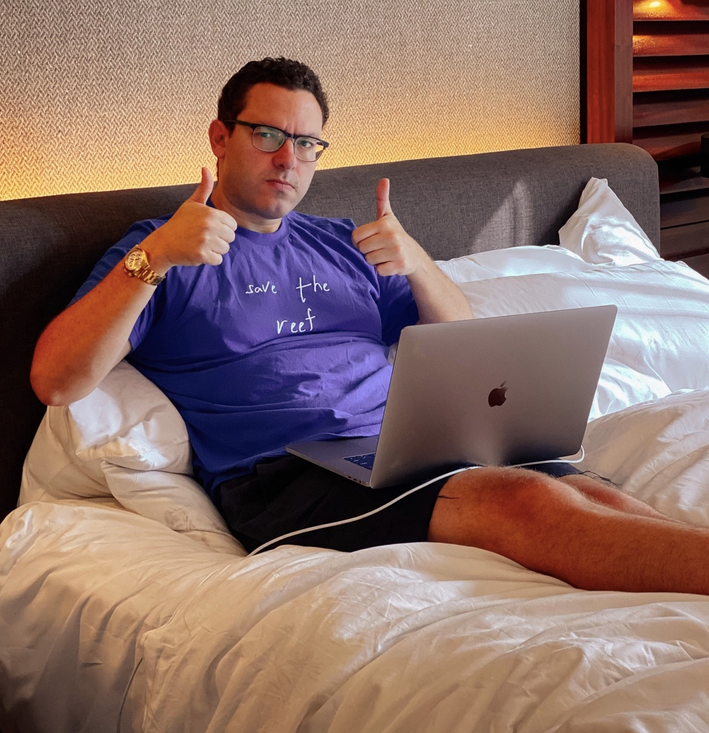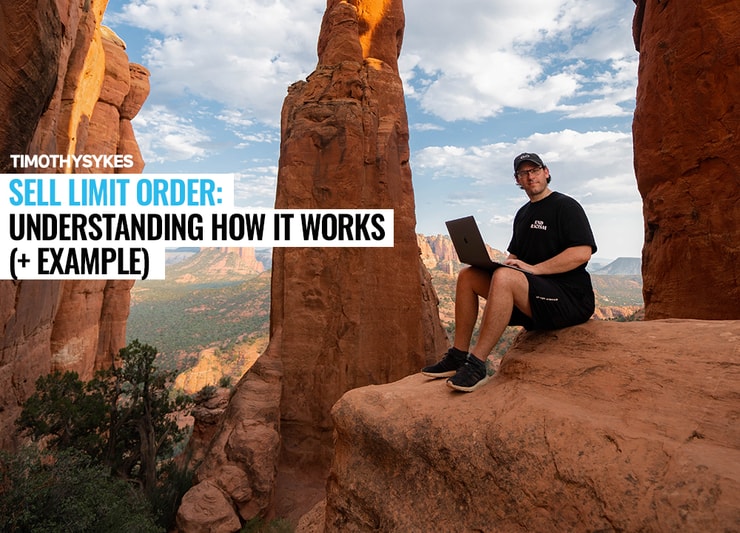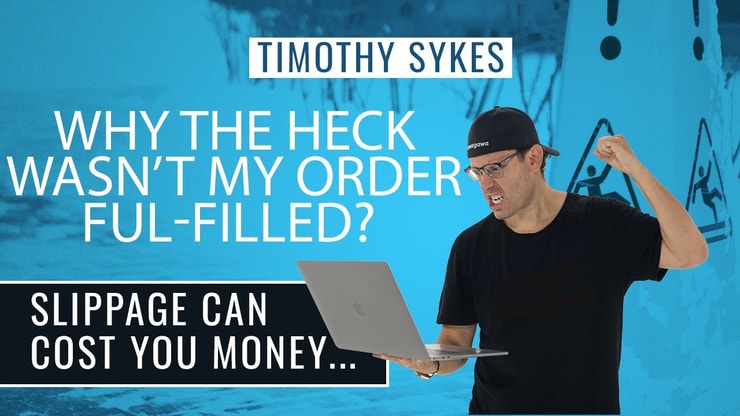To become a consistent trader, you need to really understand what a sell limit order is. Otherwise, you’re just guessing.
I never want to be just guessing — that’s why I never use market orders. Market orders can be risky, especially if you trade penny stocks like I do.
Trading can be unpredictable in a lot of ways. When you use sell limit orders, you protect yourself from price fluctuations. Those can quickly turn your small gains into big losses.
I only like price fluctuations when they work in my favor. If you need some Jedi mind tricks of your own, here’s a link to my no-cost “Volatility Survival Guide.”
Table of Contents
- 1 What Is a Sell Limit Order?
- 2 How Does a Sell Limit Order Work?
- 3 Sell Limit vs. Sell Stop: What’s the Difference?
- 4 How to Use a Sell Limit Order
- 5 Sell Limit Order Example
- 6 Sell Limit Order Advantages
- 7 Sell Limit Order Risks
- 8 Should I Use Sell Limit Orders?
- 9 Conclusion
- 10 Frequently Asked Questions About Sell Limit Orders
What Is a Sell Limit Order?
A sell limit order is a minimum price you set for selling a stock.
Think of it as a trader’s way of being a good negotiator. When you’re making a deal, you don’t say, “I’ll sell for whatever the going rate is.” You find out the rate, then kick it up a notch to what you think the market can stand.
That way, you guarantee the deal you end up making is one you’re happy with.
How Does a Sell Limit Order Work?
Now comes the part where you learn how to use limit orders.
Let’s say you enter a position at 10 cents a share. It’s the first green day. It’s already spiked up from 8 cents, and the volume is growing. You decide that it should make 15 cents before the rally ends, and you set your sell limit order at 13 cents to ensure a tidy profit.
Once the stock hits that minimum of 13 cents, your order will be filled.
One thing you’re going to need to do before using a sell limit order — shake that money mindset! If you’re targeting a price that’s too high, you might lose out on the trade altogether.
Lots of the penny stocks I trade are pumped-up garbage. They usually crash back down to earth after a hype-driven rally.
Don’t make the classic newbie mistake of going for home runs. Look for singles instead. Small gains add up.
Not sure where to draw the line? Start at the beginning with my 30-Day Bootcamp. It’s where you can learn to follow repeatable patterns and skip the get-rich-quick schemes.
Sell Limit vs. Sell Stop: What’s the Difference?
Your trading education isn’t over when you understand the bare bones of sell limit orders.
There’s another order type that some traders use: sell stop orders. These orders are meant to protect long positions with a minimum price the stock can fall to before you get out. Once the price is hit, a stop will trigger a market order.
You can combine the two in a sell stop limit order — but you don’t need to. Some traders will set one of these up on a quickly falling stock and completely miss their trading window. This is a case where more isn’t necessarily better.
If you’re going to combine a stop order and a limit order, I’d advise at least a 5- to 10-cent window to make sure your trade goes through.
On the other side are buy stop orders, often used to protect a short position. (Not that I recommend going short in this market.) Both buy and sell stops are sometimes called stop-loss orders. This is just a bit more jargon to confuse newbies.
One more wrinkle — the trailing stop limit order. This is a stop order that moves in parallel to the stock price. It only becomes fixed when the stock reverses its movement.
This is all good to know, but I don’t use stops. I use mental stops. I understand my risk tolerance and place my limit orders accordingly. It’s all about having a plan and sticking to it.
How to Use a Sell Limit Order
OK, let’s talk strategy.
First, you need to evaluate your limit price options. I usually place a sell limit order on the ask. If the stock is moving especially fast, I’ll place my limit order a few cents off the current ask. This gives my order a better chance of being filled.
This degree of inexactness works for the way I trade. I never try to buy the bottom or sell the top of a trade. What I’m looking for is the meat of the move.
Trying to get things perfect is eventually going to hurt you. That’s one of the reasons most traders lose money.
Sell Limit Order Example
A sell limit order lets you sell a stock once it reaches a specified price or higher. For example, if your stock is worth $2.25 but you want to sell at $2.40, set a sell limit order at $2.40. This ensures shares are sold only at $2.40 or more, securing targeted returns.
The other time you’ll use a sell limit order is when you want your order to be filled instantly. If you use a market order here, you open yourself to the possibility of getting less than you planned for.
Say your stock is trading at $2.25. You set your sell limit order somewhere between $2.20 and $2.25. Not only will your order likely be filled as fast as a market order, but you’ll get a price close to what you want.
Sell Stop Limit Order Example
For a lot of you, here’s where it gets tricky. But it shouldn’t. Let me show you why I never use stop orders.
You have a stock trading at $3.25 and you put a stop at $3 … just like most of the other traders out there. Or maybe you avoid that trap and place your stop order at $2.95 … like the rest of them.
Smart traders know this, and some of them use it to their advantage. They do something called “painting the tape.” They do this by placing a one-share order at a below-market price. If this becomes the ask, you and all the other cautious traders out there could get stopped out.
The stock could tumble from there, maybe below the limit you set. This could be a blessing, as all the people holding stop market orders sell for $2.65, $2.55 … $2.25.
But then the stock boomerangs back up. And you sell at your limit, just before the stock has the breakout you’d wagered on.
Sell Limit Order Advantages

2025 Millionaire Media, LLCSell limit orders have a lot of advantages over other order types. Let’s break it down…
Defined Exit Point
When you place a sell limit order, you’ve already come up with the most crucial part of your trading plan — the exit.
This kind of planning is essential if you want to be the kind of trader who actually makes money trading.
Ask my millionaire students how they got there.* They’ll tell you that they cut their losses fast. And they make sure to keep their gains.
(*Here’s my big, fat disclaimer: I can’t guarantee that you’ll be my next millionaire student. I can’t guarantee that you’ll ever be profitable in trading. These results aren’t typical. My top students have put in the time and dedication. They have exceptional skills and knowledge. They also never forget that trading is risky and that most traders lose money. Never risk more than you can afford.)
How do you do that? By knowing the price where you plan to sell.
More Breaking News
- RXRX’s Sudden Drop: Buy the Dip?
- UMC Stock: Analyzing Latest Developments
- Growth or Bubble? Decoding JetBlue’s Stock Surprise
Protection
A sell limit order is one of the best protections you have against risk.
I love to trade penny stocks. But like I said before, this isn’t because they’re good investments. They’re roller coasters, and I love that. They’ll spike on news in the morning and die a fiery death by market close. Blink and you may lose your chance to eject.
When you place a sell limit order, you’re potentially adding a layer of protection.
Sell Limit Order Risks

2025 Millionaire Media, LLCThese things aren’t magic. Like everything else in the stock market, they carry some risk. Watch out for the following…
Unfilled Orders
You need to leave a window between market price and your limit. Otherwise, there’s a chance the stock will have dropped past your limit in the time it took you to place the order. This will cause your order to go unfilled.
There’s also the risk of a partial fill for a poorly traded stock. Depending on how you customize your order, you could get stuck with several fills over one or more days. This can affect your trading plan and even the commissions you pay.
If you get sloppy and leave your limit active, you’re well on your way to the next pitfall.
Letting Your Guard Down
One of the biggest problems with limit orders is that they’re usually “good till canceled” (GTC). This is bad form for a day trader and something that can really screw up your trading plan if it’s left unattended.
But let’s say you go against this cardinal rule. Maybe you even forget the order is still in. The volatile penny stock you’re trading is poised for a breakout. But first, it dips past the trigger point of your sell limit order.
Poof, there goes your position. You’d have to buy high if you want to get back on the play.
You know what we call that? Chasing a stock — aka, doing what the hordes of idiot traders out there are doing.
Should I Use Sell Limit Orders?
Haven’t you been listening to anything I’ve been saying? Yes, you should use sell limit orders — every time you trade!
Market orders have become the default order type pushed by brokers. But guess what? Brokers don’t always have your best interests in mind.
Be smart in the age of zero commissions. Always think about how you can protect your account and manage your risk.
Conclusion
I’ll say it again: Most traders lose money.
You’ve taken the first step by learning the basics. A lot of newbies are happy with just that. If this is you, understand you’re putting yourself at more serious risk of blowing up fast.
But if you’re serious about putting in the work, I’d love to have you join my Trading Challenge. There you’ll get the training you need to make sense of the market. Maybe you’ll have the dedication to make millions, like my most dedicated students.*
Apply for the Trading Challenge here.
Do you use sell limit orders every time you trade? Or do you think I’m too harsh on market orders? Let me know in the comments!
Frequently Asked Questions About Sell Limit Orders
How Long Does a Limit Order Last?
Try to use day limit orders if you’re day trading. If your brokerage doesn’t offer them, you’ll be fitted with the good-till-canceled kind. Depending on the brokerage, these can last up to 60 days if they don’t hit the limit you set.
Can You Cancel a Limit Order?
Yes, you can and should. You never want to leave an order active and unattended. Chances are you’ll forget about it — until it gets filled when you least expect it and screws up your next trade.
Should I Sell Market or Limit?
I tell every beginning trader to use sell limit orders. I still use them myself. They matter a lot for the volatile penny stock trading that has made me $7.8 million to date. For large-cap stocks with more stability, market orders probably won’t be a disaster. But I’d still say you should build good habits and stick with limit orders.
What Is a Sell Stop Limit Order Example?
Let’s say you go long on a volatile penny stock. You use a sell stop limit order to protect yourself on the trade. You could set the stop at a 3% loss. You’d put the limit a few cents below to ensure execution.






Leave a reply